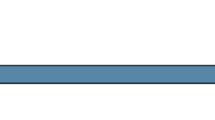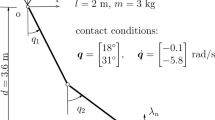Abstract
In this paper a basic, easily to multi-contact problems extendable, non-smooth approach is applied to analyze a bar striking an inelastic half-space. Coulomb contact is assumed and modeled by using set-valued Newtonian impact laws in normal as well as in tangential direction. The resulting linear complementarity problem contains all possible impact states and provides an instantaneous collision operator that respects all inequality constraints. This operator depends on the orientation of the bar and determines uniquely the post-impact velocities as functions of the pre-impact state. Different types of solutions may occur, including “stick’’ and “slip’’. In this context, stick and slip have to be understood as the two cases characterized by the tangential impulsive force as an element of either the set-valued or of the single-valued domain of the friction law. Depending on the choice of parameters, sign reversal of the tangential contact velocity is possible. For certain inertia properties and initial conditions, the collision operator yields an impact, even for initially vanishing normal contact velocity. This phenomenon is well known as the Painlevé paradox. The results obtained by this fully non-smooth rigid body approach are compared with those of other impact models, such as a lumped mass model with compliance elements, and a collision operator used for particle interactions in flows.
Similar content being viewed by others
References
Moreau, J. J., ‘Unilateral contact and dry friction in finite freedom dynamics’, in Non-Smooth Mechanics and Applications, J. J. Moreau and P. D. Panagiotopoulos (eds.), CISM Courses and Lectures, Vol. 302, Springer Verlag, Wien, 1988, pp. 1–82.
Glocker, Ch., Set-Valued Force Laws – Dynamics of Non-Smooth Systems, Lecture Notes in Applied Mechanics, Vol. 1, Springer Verlag, Berlin, Heidelberg, 2001.
Moreau, J. J., ‘Bounded variation in time’, in Topics in Nonsmooth Mechanics, J. J. Moreau, P. D. Panagiotopoulos, and G. Strang (eds.), Birkhäuser Verlag, Basel, 1988, pp. 1–74.
Pfeiffer, F. and Glocker, Ch., Multibody Dynamics with Unilateral Contacts, Wiley, New York, 1996.
Brogliato, B., Nonsmooth Impact Mechanics. Models, Dynamics and Control, Lecture Notes in Control and Information Sciences, Vol. 220, Springer Verlag, Heidelberg, New York, 1996.
Brach, R. M., Mechanical Impact Dynamics, Wiley, New York, 1991.
Stronge, W. J., James, R., and Ravani, B., ‘Oblique impact with friction and tangential compliance’, Philosophical Transactions of the Royal Society of London A 359, 2001, 2447–2465.
Walton, O, R., ‘Numerical simulation of inelastic, frictional particle–particle interactions’, in Particulate Two-Phase Flow, M. C. Roco (ed.), Butterworth-Heinemann, New York, 1992, pp. 884–911.
Wang, Y. and Mason, M. T., ‘Modeling impact dynamics for robotic operations’, in Proceedings of the 1987 IEEE International Conference on Robotics and Automation, Raleigh, NC, 1987, pp. 678–685.
Painlevé, P., ‘Sur les lois du frottement de glissement’, Comptes Rendu des Séances de l’Academie des Sciences 121, 1895, 112–115.
Génot, F. and Brogliato, B., ‘New results on Painlevé paradoxes’, European Journal of Mechanics A/Solids 18, 1999, 653–677.
Leine, R. I., Brogliato, B., and Nijmeijer H., ‘Periodic motion and bifurcations induced by the Painlevé paradox’, European Journal of Mechanics A/Solids 21, 2002, 869–896.
Cottle, R. W., Pang, J. S., and Stone, R. E., The Linear Complementarity Problem, Computer Science and Scientific Computing, Academic Press, London, 1992.
Murty, K. G., Linear Complementarity, Linear and Nonlinear Programming, Sigma Series in Applied Mathematics, Vol. 3, Heldermann Verlag, Berlin, 1988.
Glocker, Ch. and Studer, C., ‘Formulation and preparation for numerical evaluation of linear complementarity systems in dynamics’, Multibody System Dynamics, in press.
Moreau, J. J., ‘Some numerical methods in multibody dynamics: Application to granular materials’, European Journal of Mechanics A/Solids 21(Suppl. 4), 1994, 93–114.
Glocker, Ch., Dynamik von Starrkörpersystemen mit Reibung und Stössen, VDI-Fortschrittberichte Mechanik/ Bruchmechanik, Reihe 18, Nr. 182, VDI-Verlag, Düsseldorf, 1995.
Foerester, S. F., Louge, M. Y., Chang, H., and Allia, K., ‘Measurement of collision properties of small spheres’, Physics of Fluids 6, 1994, 1108–1113.
Author information
Authors and Affiliations
Corresponding author
Additional information
AMR: 160A, 160B, 160Y, 292B, 292Y
Rights and permissions
About this article
Cite this article
Payr, M., Glocker, C. Oblique Frictional Impact of a Bar: Analysis and Comparison of Different Impact Laws. Nonlinear Dyn 41, 361–383 (2005). https://doi.org/10.1007/s11071-005-8200-z
Received:
Accepted:
Issue Date:
DOI: https://doi.org/10.1007/s11071-005-8200-z




